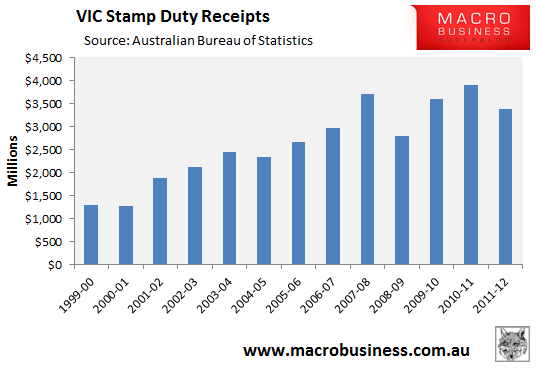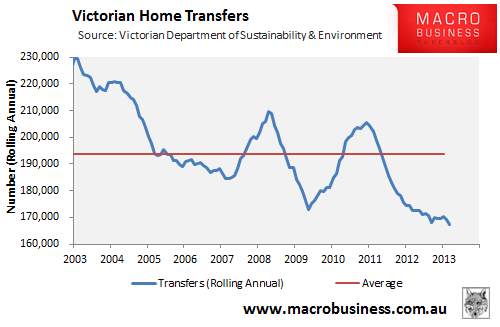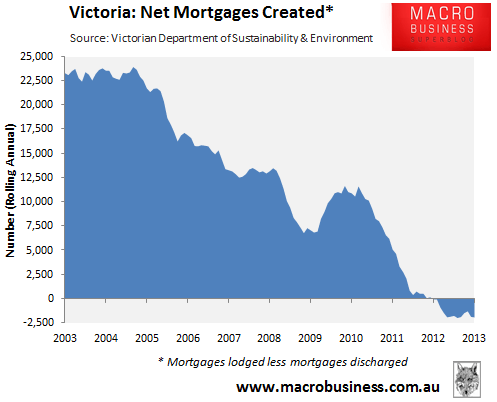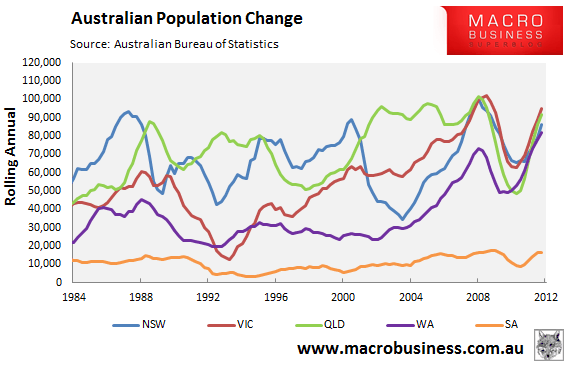
Back in December, I warned that the Victorian Government would pursue further austerity measures in a bid to sure-up government finances, but that such moves risk weakening the already fragile economy:
With budget revenues continuing to fall, there is now the risk that the state government will make further cuts to spending and jobs in attempt to return the budget to surplus. Such moves would further weaken the Victorian economy, which is already in technical recession following two consecutive quarters of negative growth in state final demand.
If anything, the situation has deteriorated further in Victoria, with the state recording its third consecutive quarter of negative growth in state final demand – suggesting the state might be in recession – with quarterly falls accelerating over that period.
Government finances have also been hit hard by falling stamp duties on property transactions, in particular, which fell by -$531 million (-14%) in the 2011-12 financial year (see next chart).

The outlook for 2012-13 is looking equally dire, with housing transfers falling to fresh lows in the year to March 2013, according to state governnment data (see next chart)

Meanwhile, Victorian households are increasingly choosing to pay back debt rather than spend, as evident by the annual number of mortgage discharges outnumbering the number of mortgage lodgements since March 2012:

The falling expenditure has also cut the state’s GST collection forecasts, which were downgraded by $6.1 billion over four years when the Coalition took office in late-2010.
As expected, the Victorian Government has signalled that it would respond to the revenue squeeze by cutting back on expenditure and infrastructure investment in order to stop the state’s debt from increasing and prevent any downgrading of its AAA credit rating. From the Weekend AFR:
Victoria’s new Treasurer, Michael O’Brien, will place retention of the state’s AAA credit rating over his goal announced this week of encouraging more big transport infrastructure with injections of public capital…
“If you massively increase your borrowings you won’t have a triple-A,” Mr O’Brien said. “There’s no point saying ‘we’ve got triple-A, let’s borrow our heads off’ because if you borrow your heads off you won’t keep your triple-A. Plunging us into debt is a self-defeating way of funding infrastructure”…
As noted last time, the Victorian Government’s predicament is a symptomatic of what happens when a government becomes overly reliant on pro-cyclical taxes like stamp duties. The booming revenues enjoyed by the former government allowed it to expand the bureaucracy to unsustainable levels and embark on billions of dollars worth of wasteful projects, such as the MYKI public transport ticketing system, the Wonthaggi desalination plant, the HealthSmart project, amongst others. Now that the stamp duty and GST rivers of gold have stopped flowing, the current Government has been left with a budgetary black hole, which it must now fill via cuts to expenditure and/or public sector jobs, or risk downgrading from the ratings agencies.
With Victoria’s population growing the fastest of any state in numbers terms (see next chart), its citizens also face declining living standards as existing infrastructure pushes up on capacity constraints, which the Government now seems unwilling to ease via new investment.

The situation in Victoria is being played out to varying degrees around the nation at both the state and federal levels.

